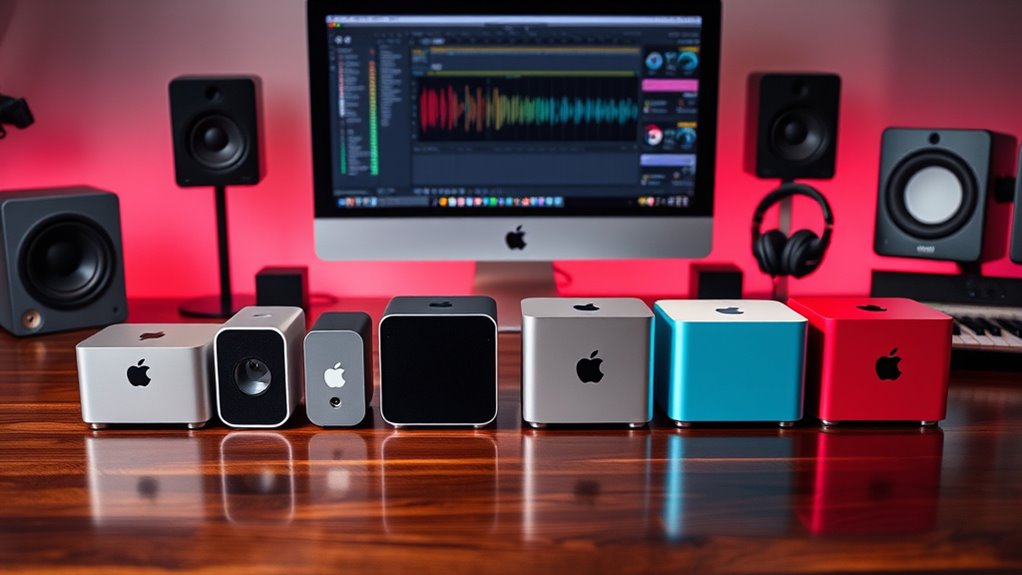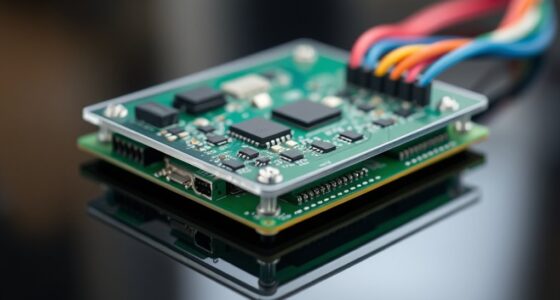If you’re looking for the best Mac minis for your home studio in 2025, I recommend considering the Apple Mac mini with M4 chip for balanced power and affordability. The M4 Pro version offers higher performance with a 12-core CPU and 16-core GPU, ideal for demanding tasks. The other options include the standard M4 and a more robust M4 Pro for future-proofing. Keep exploring to find the perfect fit for your creative needs.
Key Takeaways
- Opt for models with M4 Pro chips for demanding music and video production tasks in 2025.
- Prioritize 16GB or higher RAM configurations for smooth multitasking and future-proofing.
- Choose models with SSDs of at least 512GB to handle large project files efficiently.
- Ensure the Mac Mini has extensive connectivity options like Thunderbolt and HDMI for studio gear.
- Select a compact, quiet model with robust cooling to maintain optimal performance during long sessions.
Apple Mac mini Desktop Computer with M4 Chip (2024)
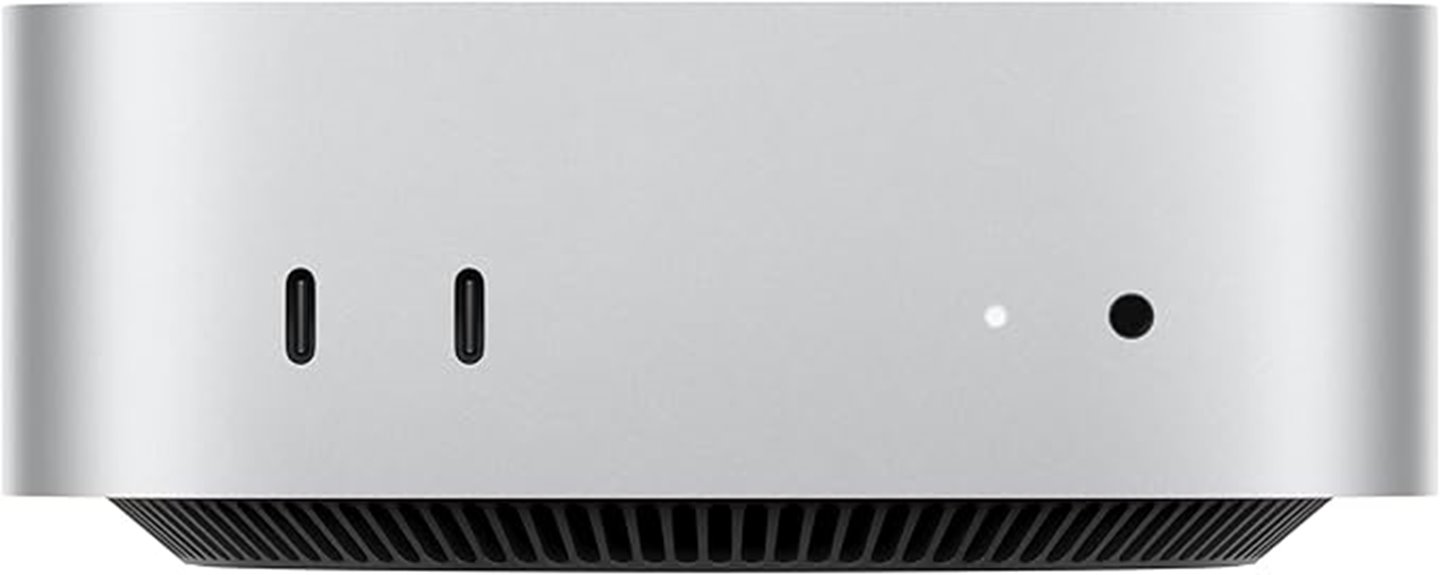
If you’re looking for a compact yet powerful workstation for your home studio, the Apple Mac mini with the M4 chip (2024) is an excellent choice. Its small five-by-five-inch design fits easily next to your monitor, yet it packs impressive performance. Powered by a 10-core CPU and GPU, 16GB of unified memory, and fast SSD storage, it handles demanding tasks like music production and video editing effortlessly. With support for multiple high-resolution displays, hardware-accelerated media engines, and seamless connectivity, this tiny powerhouse delivers speed, efficiency, and quiet operation. It’s perfect for those wanting professional capabilities in a space-saving package.
Best For: professionals and creatives seeking a compact, high-performance workstation for tasks like video editing, music production, and multitasking in a space-efficient setup.
Pros:
- Small, portable, and space-saving design fits easily into any workspace
- Powerful M4 chip with a 10-core CPU and GPU for demanding professional tasks
- Quiet operation with minimal heat generation enhances user comfort and reduces noise
Cons:
- Non-upgradable RAM and storage limit future expandability
- Limited port selection may require additional adapters for extensive connectivity
- Slightly higher price point compared to some traditional desktops with similar specs
Apple 2024 Mac mini Desktop Computer with M4 Chip
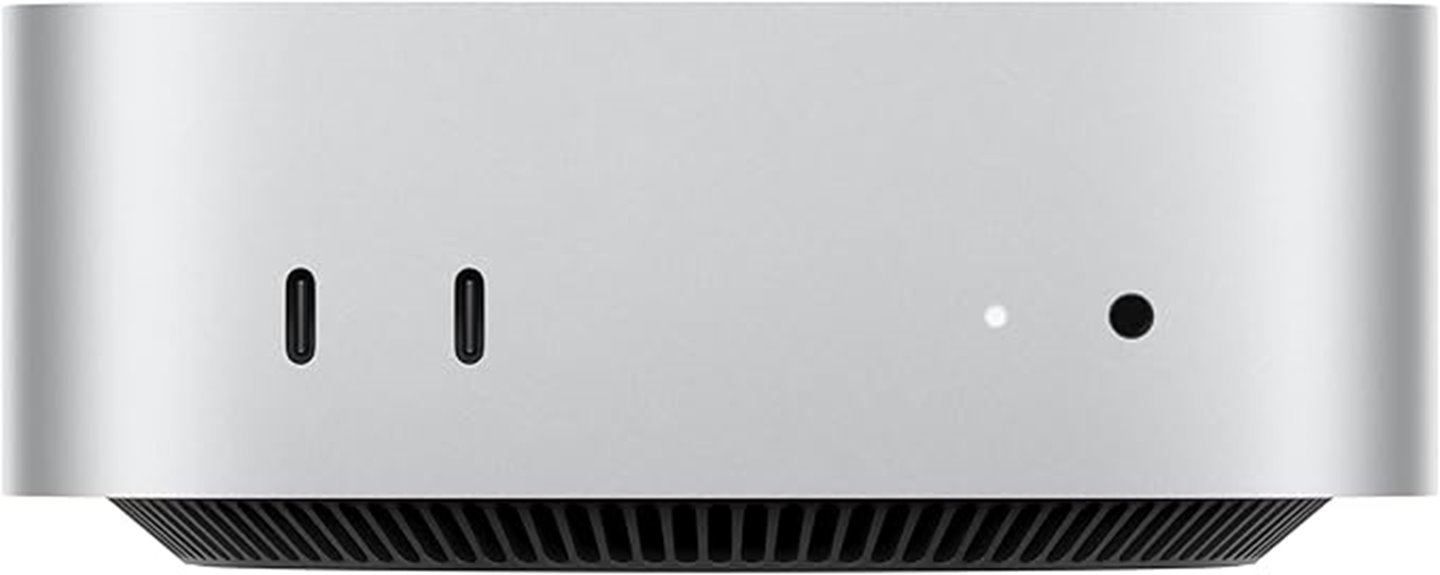
For home studio enthusiasts seeking a compact yet powerful workstation, the Apple 2024 Mac mini with the M4 chip stands out as an ideal choice. Its tiny five-by-five-inch design fits perfectly next to a monitor, saving space without sacrificing performance. Powered by the robust M4 chip, it offers a 10-core CPU, 10-core GPU, and 16-core Neural Engine, ensuring smooth multitasking, fast app launches, and efficient music or light video editing. Its build quality is praised, running cooler and quieter under load. With extensive connectivity options, support for multiple displays, and seamless integration with Apple’s ecosystem, it’s a space-saving powerhouse for any home studio.
Best For: home studio enthusiasts and creative professionals seeking a compact, powerful, and efficient desktop computer for music production, light video editing, and multitasking.
Pros:
- Small, space-efficient design that fits easily next to monitors
- Fast performance with the Apple M4 chip, ideal for multitasking and media editing
- Quiet operation with excellent build quality and thermal management
Cons:
- Non-upgradable RAM and storage, limiting future expandability
- Limited ports on the front, requiring external cables for optimal connectivity
- Higher cost relative to traditional desktops with similar specs
Apple Mac mini Desktop Computer with M4 Pro chip
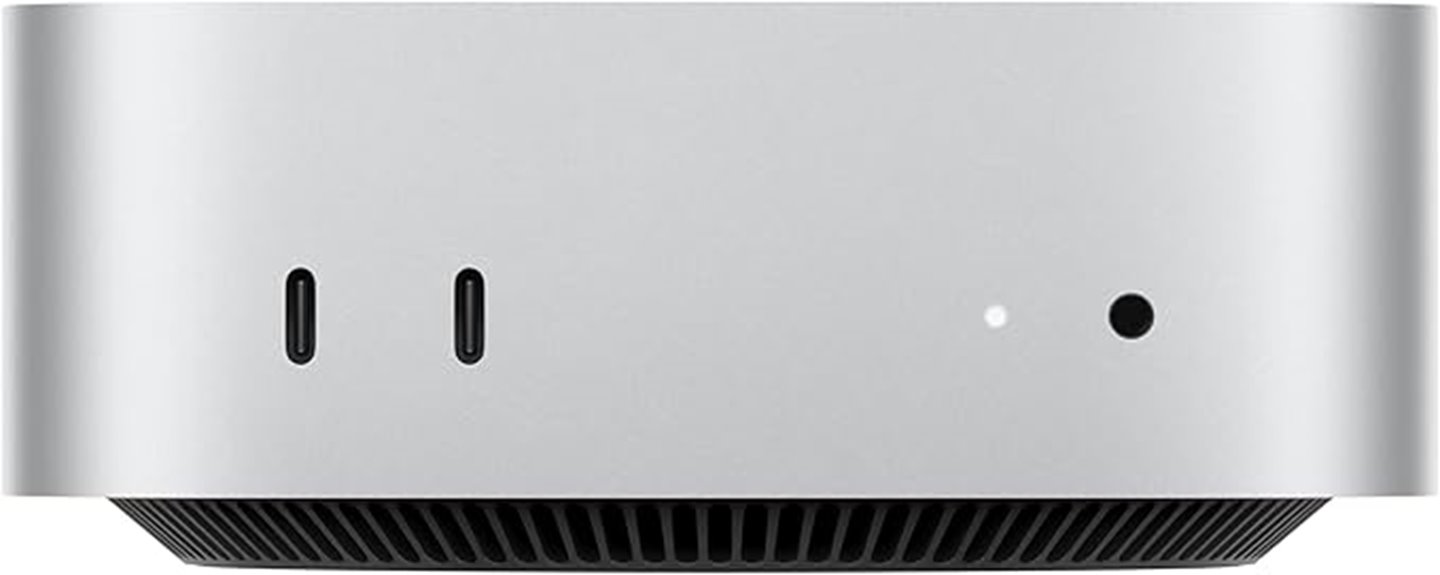
The Apple Mac mini with the M4 Pro chip stands out as an ideal choice for home studio enthusiasts who need powerful, compact performance. Its small 5×5-inch design fits easily next to monitors and blends seamlessly into any setup. Powered by the M4 Pro’s 12-core CPU and 16-core GPU, it handles demanding tasks like music production, video editing, and large projects effortlessly. With 24GB of unified memory and a 512GB SSD, it offers fast, responsive performance. Connectivity options like Thunderbolt, HDMI, USB-C, and Ethernet ensure compatibility with all your gear. Overall, it delivers desktop-level power in a tiny, versatile package perfect for studio environments.
Best For: home studio enthusiasts and creative professionals seeking a compact yet powerful desktop for music production, video editing, and demanding creative tasks.
Pros:
- Small, space-saving design that easily fits next to monitors and in tight setups
- Powered by the robust M4 Pro chip with a 12-core CPU and 16-core GPU for high-performance tasks
- Seamless integration with the Apple ecosystem and support for a wide range of professional apps
Cons:
- Limited internal storage options beyond 512GB SSD may require external drives for large projects
- No dedicated graphics card, which could impact certain high-end 3D or gaming applications
- Might be pricier compared to similarly specced Windows-based mini PCs
Apple 2024 Mac mini Desktop Computer with M4 Chip
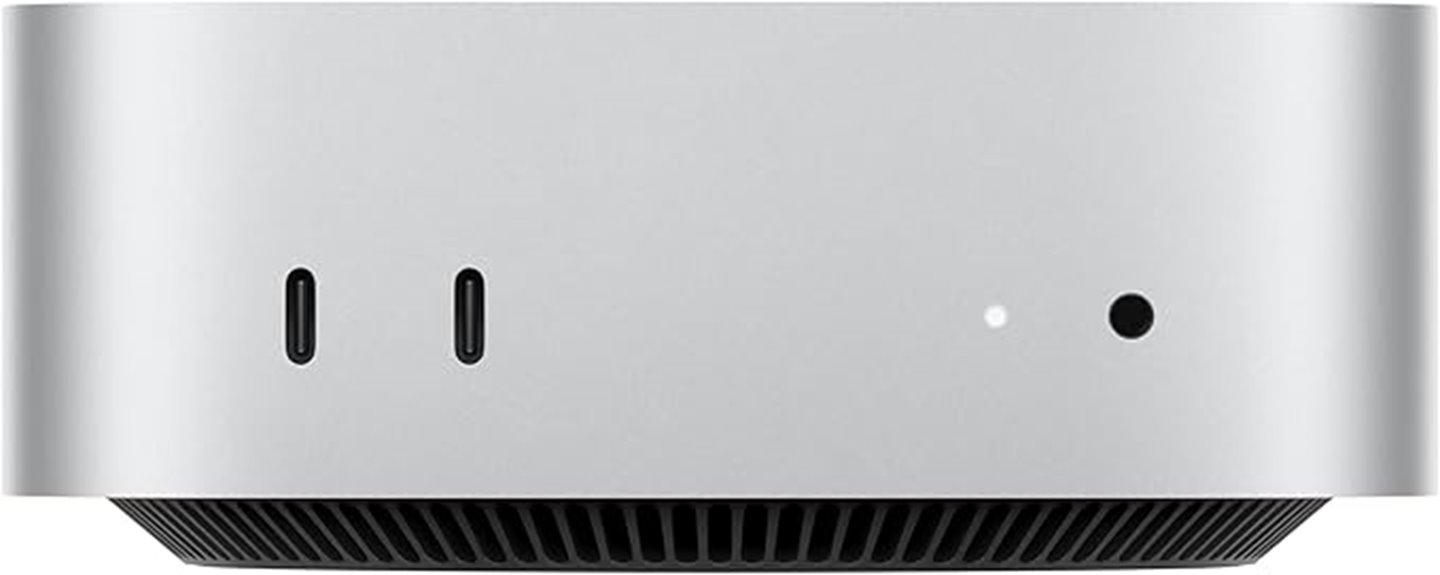
With its compact design and powerful M4 chip, the Apple 2024 Mac mini Desktop Computer stands out as an ideal choice for home studio enthusiasts who need a space-efficient yet highly capable workstation. Its five-by-five-inch size makes it easy to place next to a monitor or tucked away, while its sleek build looks great with the Apple Studio Display. Powered by a 10-core CPU and GPU, it handles light video editing, music production, and multitasking effortlessly. With up to 32GB of memory and fast SSD options, it delivers rapid performance, quiet operation, and excellent connectivity—perfect for creators needing a reliable, space-saving desktop.
Best For: creative professionals, home studio enthusiasts, and users needing a compact yet powerful desktop for light video editing, music production, and multitasking.
Pros:
- Ultra-compact size that fits easily next to monitors or in tight spaces
- Powerful M4 chip with 10-core CPU and GPU for fast performance
- Quiet operation with minimal noise under load and efficient cooling
Cons:
- Non-upgradable RAM and storage options after purchase
- Limited ports compared to larger desktops, requiring external hubs for extensive connectivity
- Higher cost for maximum configurations compared to some traditional mini PCs
Factors to Consider When Choosing a Mac Mini for Home Studio Workstations
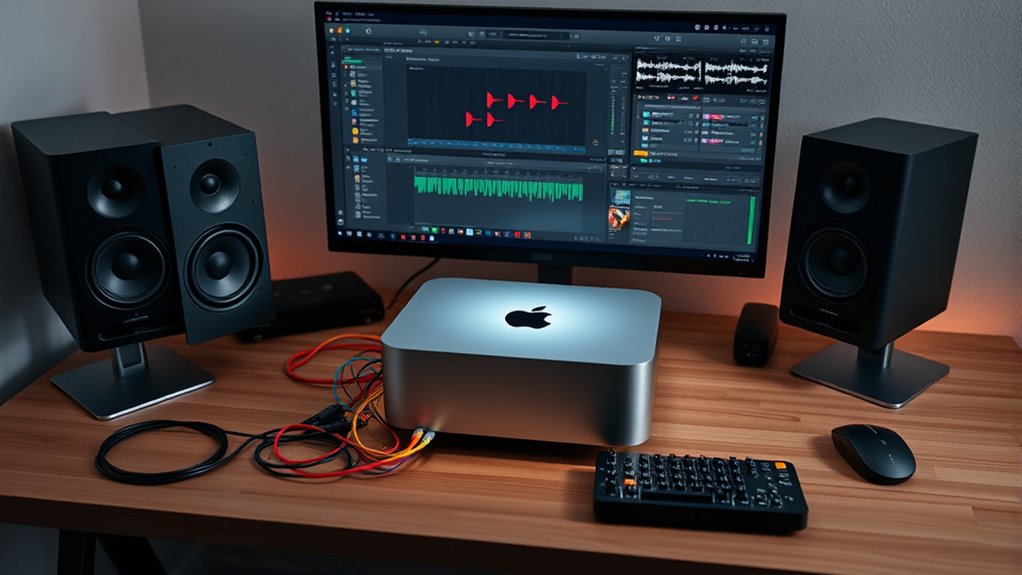
When choosing a Mac Mini for your home studio, I consider several key factors to guarantee it meets my needs. I look at processing power, memory, storage, and how well it connects to my equipment, along with compatibility with my software. Also, I pay attention to noise and heat levels to keep my workspace comfortable and quiet.
Processing Power Needs
Choosing a Mac Mini with sufficient processing power is essential for handling the demanding tasks of a home studio. High-performance CPUs, like 10-core or 12-core options, enable faster rendering and smoother multitasking, which are crucial when working on complex projects. Adequate processing capacity also reduces latency during live recordings and minimizes lag in audio processing applications. For resource-intensive software such as video editing, 3D rendering, or virtual instrument plugins, a powerful processor ensures seamless performance. Opting for a recent, high-performance chip like the M4 or M4 Pro not only meets current demands but also future-proofs your setup as studio software and plugin requirements evolve. In short, investing in robust processing power is key to maintaining efficiency and quality in your home studio.
Memory and Storage Options
Selecting the right amount of memory and storage is essential for a smooth home studio experience on your Mac Mini. I recommend at least 16GB of unified memory to handle multitasking and complex audio or video editing software efficiently. If you’re working with large sample libraries, multiple tracks, or resource-intensive plugins, upgrading to 24GB or 32GB of RAM makes a noticeable difference. For storage, opt for 512GB or more if your projects involve sizable files or high-resolution media. External SSDs are also a smart choice to expand storage and boost data transfer speeds, especially for large audio or video files. Keep in mind, some Mac Mini models have non-upgradable RAM and storage, so choose your specifications carefully when purchasing to future-proof your setup.
Connectivity and Expansion
Ensuring your Mac Mini has the right connectivity options is essential for building an efficient home studio setup. You’ll want enough Thunderbolt 4 (USB-C) ports, HDMI, and USB-A or USB-C ports to connect audio interfaces, MIDI controllers, and external drives without hassle. High-speed Ethernet, preferably 10Gb, is crucial for fast data transfer and reliable network connectivity, especially for streaming and cloud-based workflows. Make sure the device can support multiple high-resolution monitors through Thunderbolt and HDMI outputs to create an expansive workspace. Check that ports support the necessary data transfer rates for large audio and video files, preventing bottlenecks during production. Additionally, look for audio connections like headphone jacks and multichannel audio support, which are vital for seamless monitoring and recording.
Compatibility With Software
To get the most out of your home studio, it’s essential to verify that your Mac Mini’s software environment is fully compatible with your preferred digital audio workstations (DAWs), plugins, and multimedia tools. First, ensure your macOS version supports the software you plan to use, as updates can impact compatibility. Check that the hardware specifications meet the minimum and recommended requirements for your DAWs and plugin suites to ensure smooth performance. It’s also important to confirm external audio interfaces and MIDI controllers work seamlessly with macOS and your Mac Mini’s ports. Additionally, if you’re into video editing, verify that the GPU and media engines support hardware-accelerated features. Lastly, consider whether your software ecosystem is optimized for Apple Silicon to future-proof your setup.
Noise and Heat Levels
Modern Mac Minis with Apple Silicon chips run cooler and quieter under load than their older Intel counterparts, making them especially suitable for noise-sensitive home studios. Their compact design helps dissipate heat efficiently, reducing the need for active cooling fans and minimizing background noise. This lower heat output also decreases the risk of thermal throttling, ensuring steady performance during long studio sessions. The optimized hardware and thermal management systems allow these Macs to operate quietly, creating a more comfortable environment for recording and mixing. For added silence, some models feature enhanced cooling or fanless designs, further reducing noise levels. Overall, these improvements make Apple Silicon-based Mac Minis an excellent choice for anyone prioritizing a quiet, thermally efficient workstation.
Budget and Value
When choosing a Mac Mini for your home studio, it’s important to balance the cost with the features you need. I recommend considering models that meet your performance requirements without overspending on unnecessary specs. Evaluate whether the hardware, like CPU, GPU, and memory, justifies the price for your audio or video projects. Keep in mind additional expenses for peripherals, storage, and software, as these can quickly add up. Investing in a higher-tier model with more RAM and storage might cost more upfront but offers better long-term value, especially as your projects become more demanding. Comparing different configurations’ price-to-performance ratio helps ensure you get the best bang for your buck, making your setup both powerful and budget-conscious.
Frequently Asked Questions
How Does the M4 Chip Compare to Previous Mac Mini Models for Music Production?
The M4 chip markedly outperforms previous Mac Mini models for music production. I’ve noticed faster processing, smoother multitasking, and better handling of demanding audio plugins. The improved GPU and neural engine make real-time mixing and editing more efficient. Overall, the M4 offers a robust, future-proof setup that elevates my studio experience, making it a top choice for serious musicians and producers looking for power and reliability.
Can the Mac Mini Support Multiple High-Resolution Monitors Simultaneously?
Yes, the Mac Mini can support multiple high-resolution monitors simultaneously. I’ve used mine with two 4K displays effortlessly, thanks to its Thunderbolt 3 and HDMI ports. This setup boosts my productivity and makes it easier to manage multiple tracks and plugins. Keep in mind, the exact number and resolution depend on the specific model, but generally, the Mac Mini handles dual high-res monitors very well for home studio work.
What Are the Best Peripherals to Optimize a Home Studio With a Mac Mini?
Imagine your creative space coming alive—my favorite peripherals make this possible. I swear by a high-quality audio interface, like the Focusrite Scarlett, to capture every nuance. A precision MIDI controller fuels my inspiration, and a pair of studio monitors like the KRK Rokits deliver crystal-clear sound. Don’t forget a reliable external SSD for quick access to your projects. These tools turn my Mac Mini into a powerhouse studio—yours can be, too.
How Upgradeable Is the RAM and Storage in the 2025 Mac Mini Models?
The 2025 Mac Mini models are not upgradeable regarding RAM and storage, as these components are soldered onto the motherboard. I recommend choosing a configuration with sufficient RAM and storage at purchase because upgrades later aren’t possible. This means I always advise carefully considering my needs upfront to avoid limitations down the line. Planning ahead helps me get the most out of my Mac Mini initial investment.
What Software Compatibility Issues Might Arise With the New M4 Chips?
Like the Wright brothers faced early flight challenges, I worry about software compatibility with the new M4 chips. Some older applications, especially niche audio or music software, might not run smoothly or require updates. It’s wise to verify developers’ support pages or forums. I recommend testing critical programs early or waiting for official updates to ensure your home studio runs seamlessly without surprises.
Conclusion
Choosing the right Mac mini is like building a musical ensemble—you want each component to harmonize perfectly. Whether you opt for the M4 or M4 Pro, these models are powerful instruments that can turn your home studio into a symphony of creativity. Think of them as the steady drumbeat that keeps your projects moving forward smoothly. With the right choice, you’ll be orchestrating your best work in 2025 and beyond.
